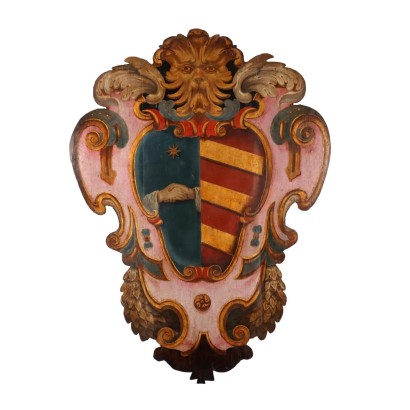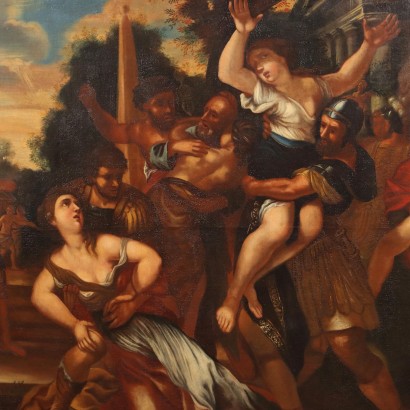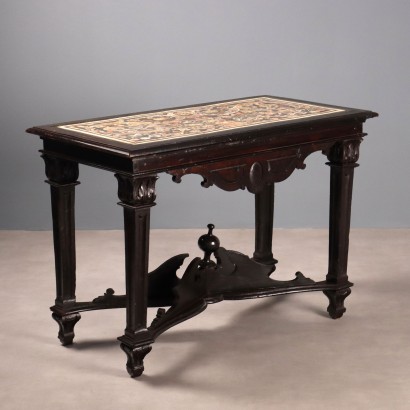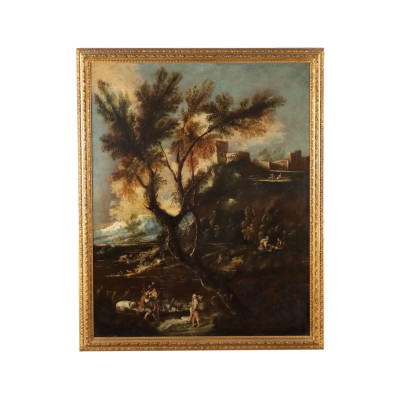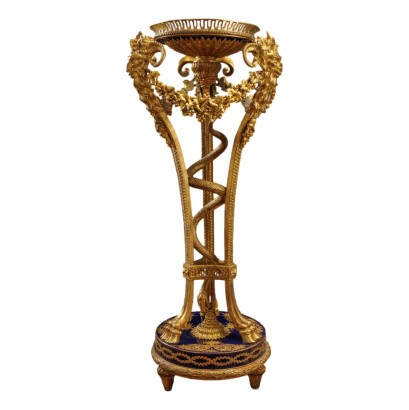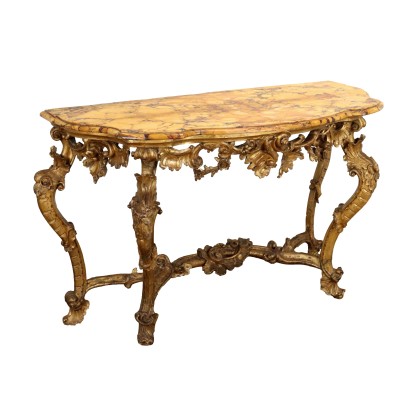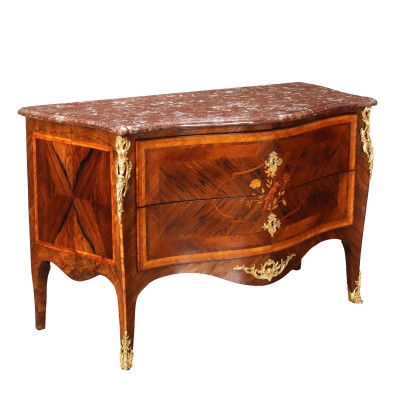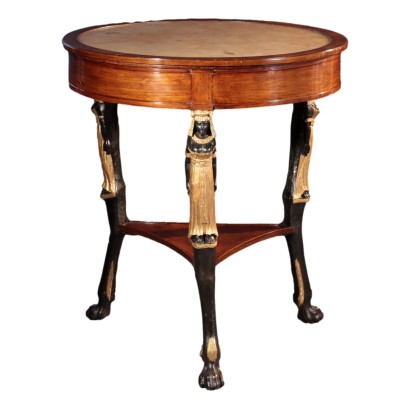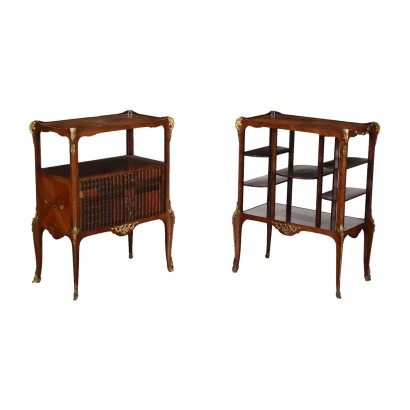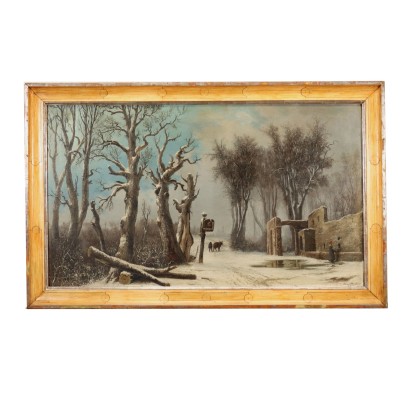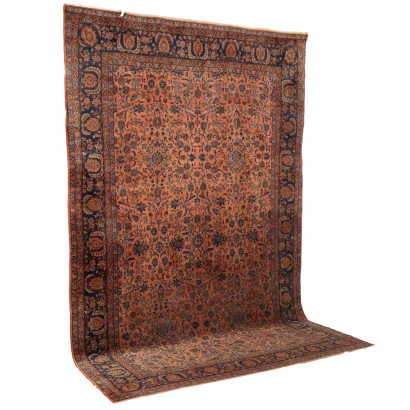Antique Baroque Coat of Arms Pasqui Poplar Florence XVIII Century - Florence, Early XVIII Century
Features
Florence, Early XVIII Century
Style: Baroque (1630-1730)
Age: 18th Century / 1701 - 1800
Origin: Firenze, Toscana, Italy
Main essence: Poplar
Material: Painted Wood , Gilded Wood
Description
Large baroque coat of arms enclosed within a crumpled box, made of poplar painted in polychrome and partially gilded, Florence, early 18th century. The crumpled piece is characterized by a symmetrical design composed of volutes of strong architectural style and is surmounted by a mask placed within leafy elements in the form of wings, while in the lower section it presents a laurel festoon which, developing from the sides, ends up serve as a background. Lambrecchini, bows with galls and a rosette-shaped button further adorn the crumpled. In the centre, placed within a shield composed of curls, stands the insignia of the Pasqui family ("D'azzurro, alla faith di complexion, [...], surmounted by an eight-pointed gold star"), flanked by a red and gold bandit. Gold is used both to create some of the decorations and to define the profile of curls and volutes, helping to give the coat of arms a three-dimensional perspective effect (trompe-l'oeil). Restorations and touch-ups in color. The Pasqui family is a very ancient family of Tuscan origins, which since 1200 has figured in the roles of the Santo Spirito district of Florence, where it had a stable residence until 1300. It was also ascribed to Florentine citizenship in 1606.
Product Condition:
Object restored by the experts of our restoration laboratory. We try to present the real state of the object as completely as possible with photos. If some details are not clear from the photos, what is stated in the description applies.
Dimensions (cm):
Height: 177
Width: 130
Depth: 10
Additional Information
Style: Baroque (1630-1730)
Read more
The term derives from the Spanish barrueco phoneme or Portuguese barroco and literally means "shapeless pearl".
Already around the middle of the eighteenth century in France it was synonymous with uneven, irregular, bizarre, while in Italy the term was of Medieval memory and indicated a figure of the syllogism, an abstraction of thought.
This historical period was identified with the derogatory term baroque, recognizing in it extravagance and contrast with the criteria of harmony and expressive rigor to which it was intended to return under the influence of Greco-Roman art and the Italian Renaissance.
Baroque, seventeenth-century and seventeenth-century were synonymous with bad taste.
As regards furniture, freedom of ideation, need for pomp and virtuosity gave rise to a synergy destined to produce unsurpassed masterpieces.
The materials used were worthy of competing with the most astonishing tales of Marco Polo: lapis lazuli, malachite, amber, ivory, tortoiseshell, gold, silver, steel, precious wood essences and more dressed the furnishings that in shape and imagination virtually gave life to the Arabian Nights of many of our powerful people.
Typical of the period were load-bearing or accessory parts resolved with twisted column motifs, clearly inspired by Bernini's canopy of St. Peter's, parts with rich sculptural carving in high relief and even in the round within a vortex of volutes, scrolls and spirals, curved and broken profiles, cymatiums agitated by gables of articulated shape, aprons adorned with ornaments, corbels, buttresses and so on. necessary to enliven shapes and structures.
The Baroque is also the century of illusionism: lacquers and thin temperas crowd furniture and furnishings to imitate with the marbling effects of marble veining or games of veining of precious briar roots.
Find out more about the Baroque with our insights:
Classic Monday: a double-body sideboard, late Venetian Baroque
Classic Monday: a pair of candle holders between the Renaissance and Baroque
Classic Monday: a pair of mirrors between Baroque and Late Baroque
Age: 18th Century / 1701 - 1800
18th Century / 1701 - 1800Main essence: Poplar
Essence considered "poor", it is a white wood, with yellowish or greyish shades, light and tender, which is easily damaged. It is used for rustic furniture or in the construction of furniture. The most valuable use it has had in the history of furniture is in Germany, in the 19th century, for veneers and inlays in the Biedermeier period.Material:
Painted Wood
Gilded Wood
Other customers have searched:
Se ti appassiona l'antiquariato, scopri qui tutte le presentazioni dei prodotti antichi più belli, eleganti e preziosi su FineArt by Di Mano In Mano
Leggi di più
Sull'antiquariato in generale dai un'occhiata anche a:Classic Monday: da un pezzo dei nostri magazzini alla storia dell'antiquariato
L'antiquariato dalla A alla Z: il Dizionario dell'Antiquariato
Il dizionario dell'antiquariato - Lastronatura
Il dizionario dell'antiquariato - Mascherone
Il dizionario dell'antiquariato - Natura morta
Il dizionario dell'antiquariato - Opificio
Il dizionario dell'antiquariato - Pastiglia
Il dizionario dell'antiquariato - Savonarola
Il dizionario dell'antiquariato - Rosone
Intaglio barocco con motivo a ricciolo
Infine, dai un'occhiata alle nostre rubriche di divulgazione sulla storia delle arti decorative e d'arredo:
Epoche
Lavorazioni e tecniche
Mostre ed Eventi
Protagonisti
Product availability
The product can be seen at Cambiago
Immediate availability
Ready for delivery within 2 working days from ordering the product.

